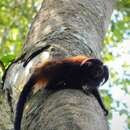Biology
provided by Arkive
This species eats fruits, insects, flowers, nectar, berries, seeds, young leaves, bird eggs and small vertebrates such as frogs, lizards and nestlings (2). It is active in the day and arboreal, sleeping in tree holes at night. Black lion tamarins live in groups of around 2 to 3 adults and their offspring, and social bonds are maintained through food sharing and calling (5). Vocalisations and scent marking also serve to broadcast the presence of a group within their territory (5); the hair may stand on end during aggressive exchanges over territorial issues (5). Other forms of communication include shrill, bird-like vocalisations and a few facial expressions (6). All lion tamarins tend to give birth to twins, but triplets and quadruplets have also been observed (5).
Conservation
provided by Arkive
A long-term programme of conservation and environmental education targeting the black lion tamarin is underway (7). An important measure to combat the effects of inbreeding will be to allow movement of individuals between the isolated sub-populations. This can occur through translocations of individuals or by creating corridors between habitat patches to facilitate movement between populations (4). Corridors have already been planted and some translocations have occurred (7). There is currently a captive population of around 100 individuals, which require the occasional incorporation of wild individuals to maintain genetic variation (7).
Description
provided by Arkive
The squirrel-sized black lion tamarin is one of the world's most endangered mammals (4). Also known as the golden-rumped lion tamarin, this species has glossy black fur with varying amounts of reddish-golden fur on the rump, thighs and base of the tail (2) (5). The long mane framing the face is black. Like the closely related golden lion tamarin, the black lion tamarin has long digits that are used to forage for small insects (5).
Habitat
provided by Arkive
Inhabits remnants lowland semi-deciduous forest and macega, which consists of low bushy trees (2) (5).
Range
provided by Arkive
Recorded only from the interior region of the Brazilian state of São Paulo (4). The black lion tamarin was believed to be extinct from 1905, until it was rediscovered in 1970 in a reserve in south-western São Paulo. At that time it was estimated that the population numbered fewer than 100 individuals (4). At present, about six populations are known, and the number of remaining individuals is estimated to be less than 1000 (6).
Status
provided by Arkive
Classified as Critically Endangered (CR B1 + 2abcde, C2a) on the IUCN Red List 2002 (1), and listed on Appendix I of CITES (3).
Threats
provided by Arkive
Over 90% of the Atlantic forest in Brazil has been lost to logging, development and cultivation. The species is also vulnerable to fire and hunting (4). Areas of prime habitat occur in and around the Morro do Diabo State Park; however, 5% of this area was flooded in the early 1980's, following the construction of a hydroelectric plant (7). The remaining black lion tamarin populations have been isolated for some time, and studies have shown that genetic diversity is extremely low as a result of inbreeding (7). Inbreeding depression, which can reduce the fitness of the population in terms of survival, reproductive capacity and growth, is therefore a cause for concern in this species.

